Henderson's shooting star Dodecatheon hendersonii

ABOUT
Commonly known as Henderson's shooting star, this plant features a rosette of oblong to lance-shaped leaves at its base. The leaves are often a rich green, sometimes with a hint of blue or glaucous appearance. In the flowering season, a single, erect, slender stem arises from the center of the leaf rosette, topped by an umbel of distinctive flowers. The blossoms of the Henderson's shooting star are especially striking, characterized by their swept-back petals, which give them a reflexed, shooting star appearance. Each flower consists of four to five petals that generally range in color from deep magenta to pale pink, and are sometimes almost white. The petals curl backward from the flower's center where a cluster of bright yellow stamens extend outward, giving the flower a unique and eye-catching contrast. The inflorescence is generally a raceme, meaning the flowers are arranged on the stem in a way that each one stems from a single point and they bloom in succession from the bottom up. The overall effect of the blooming Henderson's shooting star is quite showy, often creating a visual spectacle during its flowering phase. Once the flowering season is over, the plant forms a seed capsule, which will eventually split open to release the seeds for the next generation of Henderson's shooting stars. Throughout its life cycle, this plant maintains a somewhat delicate and graceful structure, with its most remarkable feature being the captivating, comet-like blooms that seem to dance atop their slender stems.
About this plant
 Names
NamesFamily
Primulaceae
Synonyms
Broad-Leaved Shooting Star, Henderson's Shooting Star, Mosquito Bills
Common names
Dodecatheon hansenii, Dodecatheon hendersonii var. hansenii, Dodecatheon pavoninum.
 Toxicity
ToxicityTo humans
The Dodecatheon hendersonii, commonly known as Henderson's shooting star, is not widely known to be toxic to humans. There is limited information on its toxicity. However, as with many plants, it is generally recommended to avoid ingesting parts of plants that are not known to be edible as they may contain compounds that could be harmful or cause allergic reactions in some individuals.
To pets
Henderson's shooting star is also not widely recognized as being poisonous to pets. However, the general advice for any plant not known to be safe is to prevent pets from ingesting it. If a pet does consume any part of the plant, monitor them for any signs of illness and consult a veterinarian if any adverse symptoms appear. Without specific toxicity data for Henderson's shooting star, caution is advised.
 Characteristics
CharacteristicsLife cycle
Perennials
Foliage type
Deciduous
Color of leaves
Green
Flower color
Pink
Height
1 foot [30 cm]
Spread
1 foot [30 cm]
Plant type
Herb
Hardiness zones
7
Native area
North America
Benefits
 General Benefits
General Benefits- Attracts Pollinators: Dodecatheon hendersonii is known for its attractive flowers that lure in pollinators such as bees and butterflies, which are vital for the pollination of many other plant species.
- Aesthetic Appeal: With its unique umbrella-shaped flowers and striking appearance, it adds aesthetic beauty to gardens and landscapes.
- Native Plant Conservation: Being a native species, it plays a role in native gardening movements which aim to preserve local flora and fauna.
- Habitat for Wildlife: The plant provides shelter and food for various insects and small wildlife, contributing to biodiversity.
- Erosion Control: By establishing its roots in the soil, Dodecatheon hendersonii helps to stabilize soil and prevent erosion.
- Low Maintenance: Once established, it is relatively low maintenance, requiring minimal additional watering or care, making it a convenient choice for gardeners.
- Educational Interest: It can be used as an educational tool to teach about native plants and their ecological roles.
- Seasonal Interest: It blooms primarily in spring, offering seasonal interest with a splash of color when many other plants have not yet flowered.
 Medical Properties
Medical PropertiesThis plant is not used for medical purposes.
 Air-purifying Qualities
Air-purifying QualitiesThis plant is not specifically known for air purifying qualities.
 Other Uses
Other Uses- Dodecatheon hendersonii, commonly known as Henderson's shooting star, can be used as a natural dye source. The roots and flowers can be processed to yield colors for textiles.
- Its unique floral structure serves as an educational tool in botany classes to demonstrate pollination mechanics, as it has a distinctive pollination method involving bumblebees known as buzz pollination.
- Due to their attractive appearance, Henderson's shooting stars are used in wildflower photography, often appearing in botanical guides and photo books.
- The plant can be incorporated into native plant gardens and restoration projects to provide ecological benefits such as supporting local wildlife, especially pollinators specific to the region.
- Henderson's shooting stars are sometimes used in ornamental crafts, such as pressing the flowers for inclusion in natural art pieces or homemade paper products.
- The plant can serve as a "marker species" in ecological studies to help assess the health of a particular ecosystem, especially in its native regions.
- In some cultures, the plant is incorporated into ceremonies or artistic representations as a symbol of purity and the coming of spring due to its early bloom period.
- Henderson's shooting star is occasionally used in landscape design for rain gardens because of its preference for moist, well-draining soils.
- The plant plays a role in captive rearing programs for pollinators like certain bee species, serving as an early-season food source in controlled environments.
- Its sequential blooming nature makes Henderson's shooting star a subject of interest for those studying the temporal dynamics of flowering and plant-pollinator interactions.
Interesting Facts
 Feng Shui
Feng ShuiThe plant Shooting Star is not used in Feng Shui practice.
 Zodiac Sign Compitability
Zodiac Sign CompitabilityThe plant Shooting Star is not used in astrology practice.
 Plant Symbolism
Plant Symbolism- Charm: Henderson's Shooting Star, with its unique shooting-star shape, traditionally symbolizes charm and attractiveness, as if nature itself was cast under a spell to create such an intriguing form.
- New Beginnings: The emergence of this flower in early spring associates it with new beginnings and the renewal of the earth after winter's sleep.
- Magic: Its distinct appearance gives Henderson's Shooting Star a touch of the magical, as it stands out among other flowers with simplicity and grace, representing the unexpected wonders of nature.
- Love: In some folklore, shooting stars are believed to fulfill wishes, similarly, Henderson's Shooting Star may be associated with love and the fulfillment of the heart’s desires.
- Inspiration: Its star-like petals can symbolize inspiration, guiding individuals much like how stars were used for navigation and aspiration.
 Water
WaterFor the Shooting Star plant, it is best to mimic its native woodland habitat by maintaining evenly moist soil without letting it become waterlogged. Water the plant deeply once a week, providing about one gallon per square yard, adjusting for rainfall. During the active growing season in spring, you may need to water more frequently, especially if the weather is dry. In the summer, as the plant goes dormant, reduce watering significantly. Keep in mind that overwatering can be just as detrimental as under-watering, so make sure the soil drains well and adjust your watering schedule according to the temperature and humidity.
 Light
LightShooting Stars thrive in partial shade, ideally receiving morning light and shelter from the intense afternoon sun. They perform well under the dappled light of a woodland garden or in a north-facing position where they can receive bright indirect light. Direct sunlight can scorch their delicate foliage, so be sure to place them in a location that simulates the light conditions of their natural environment.
 Temperature
TemperatureShooting Stars prefer cool temperatures ranging between 40 to 75 degrees Fahrenheit. They can endure a minimum temperature of around 20 degrees Fahrenheit and can survive short periods of colder weather if necessary, but they are not suited to hot climates with temperatures consistently above 80 degrees Fahrenheit. The ideal conditions for this plant are similar to those of its native Pacific Northwest habitat, with mild temperatures and cooler nights.
 Pruning
PruningPruning of Shooting Stars is generally done to remove spent flower stalks after blooming and to tidy up any dead or damaged foliage. This not only encourages a tidier appearance but can also promote health by removing potential disease sources. Pruning is usually needed once a year, best done soon after flowering in late spring or early summer. There is no need for extensive pruning; simply cut back the flower stems to the base of the plant.
 Cleaning
CleaningAs needed
 Soil
SoilShootings stars require a well-draining soil mix with high organic content. A blend of peat, perlite, and garden loam is ideal. The soil pH should be mildly acidic to neutral, ranging from 6.0 to 7.0 for optimal growth.
 Repotting
RepottingShootings stars should be repotted every 2-3 years. They have a dormant period after flowering when repotting is best done, ensuring minimal stress to the plant.
 Humidity & Misting
Humidity & MistingShootings stars thrive best in moderate humidity levels, ideally between 40-60%. They can tolerate a bit more humidity, but the air should not be too dry, as they are native to moist and cool climates.
 Suitable locations
Suitable locationsIndoor
Place in bright indirect light with cool temps and moist soil.
Outdoor
Part shade, moist soil, protect from hot afternoon sun.
Hardiness zone
5-9 USDA
 Life cycle
Life cycleDodecatheon hendersonii, commonly known as Henderson's shooting star, begins its life as a seed, typically germinating after experiencing cold winter temperatures, a process known as cold stratification. Upon sprouting in the spring, the seedling develops into a rosette of leaves close to the ground, engaging in photosynthesis and developing a storage organ called a corm. As the plant matures, it undergoes vegetative growth annually, with leaves dying back in the summer, entering a period of dormancy during the hotter, drier months. Following dormancy, and with the return of cooler, wetter conditions, it resumes growth, drawing on the energy reserves of the corm, and prepares for the flowering stage, which typically occurs in the early spring. Henderson's shooting star produces a striking flower stalk bearing an umbel of magenta, pink, purple, or white blooms with reflexed petals, which are pollinated by bees and other insects. After pollination, the plant sets seed, which is dispersed near the parent plant, thus completing its life cycle.
 Propogation
PropogationPropogation time
Spring
The most popular method of propagating the plant commonly known as Henderson's shooting star is through seed sowing. Seeds should be collected from ripe capsules in late spring to early summer, as soon as they have turned a light brown color. These seeds can then be sown immediately in a cold frame or directly outdoors in a prepared seedbed. They require a period of cold stratification to germinate effectively, so fall sowing naturally provides this. If sowing in spring, the seeds need to be artificially stratified by placing them in a sealed bag with some moist sand or vermiculite and refrigerated at a temperature of around 40 degrees Fahrenheit (4 degrees Celsius) for about four to six weeks. After stratification, the seeds are sown on the surface of a well-draining soil mix and are kept moist until germination, which takes place after the cold period, often in early spring as temperatures rise. Seedlings can then be carefully transplanted to their permanent positions when large enough to handle.









